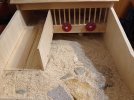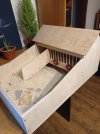Hello Everyone!
I'm kind of new to this forum, I've been reading a dozen of threads in the last couple of months, and have learned many things, but I feel like the more I read, the more confused and overwhelmed I am with all this information out here.
(and I know, all of my following questions have already been answered, I've read a lot of them as well, but as I said, I'm just confused?)
I've got a hermann's tortoise 3 months ago, who was born in 2019 according to his papers, and (of course, like every nice people here) would like to give him the best life I can.
He currently lives in a cool viking-style (only for my pleasure, sadly he doesn't know how cool that is) 2 level tortoise table. The bottom floor is 30.7x20.9" (78x53 cm), and the top floor is 10.2x20.9" (26x53 cm), which I will attach picture of.
His ramp will be ribbed, so he can walk up easier.
As I read, the 2 most preferred beddings were cypress mulch and coco coir. Sadly there is literally no cypress mulch where I live. I've tried coco coir, but it molded like crazy after just 3-4 days.
As for now, he has minced cob as a bedding, with some rocks, but I believe it is really dry for him. I also didn't really like the smell of the coco coir, as the tortoise is in the same room, where I am almost 24/7.
I soak him around every 2-4 days, and recently added a little water dish, what he loves.
They gave us I think the most basic tortoise food, what honestly I don't know what exactly contains, but I will attach a picture of that too, hopefully some more experienced keepers will know if that food is ok for him. It is not fluffly, and easy to break, like basic turtle foods, it's actually pretty solid.
I feed him 2 times a day with 3 pieces of this given food mixed with a calcium powder, and some water.
He currently only has a 25W heat bulb, with no UVB. The heat bulb is on for 10 hours a day (sometimes a little longer, if I feed him later)
The temperature in the room where the tortoise table is is around 75-81 fahrenheit (24-27 Celsius).
And also, I plan to get a thermostat, so I can keep track on the degrees, and the humidity.
The question after this long intrudoction is..well..almost everything.
1. I know, it's not ideal to feed him with only this food, what other things I should feed him with?
2. Most people say that you need an UVB lamp, some people say that if you put him outside for a couple of hours every few days, it should be fine.
I live in Hungary, in a small apartment, so sadly an outdoor enclosure is not an option here, but I have a balcony, where I think it would be good for him if I put him out every now and then.
I wonder if that UVB is enough for him, or I should get a lamp.
And if that UVB is enough, what the temperature should be so I can put him outside for a couple of hours.
3. It doesn't matter that he has a water bowl, I should still soak him, right?
4. What other bedding would be suitable for him? As I read, pine mulch is not suitable, and maybe nut tree mulch is not suitable as well. I guess self mowed (not store bought) lawn is not suitable for him as well.
5. As for humidity, I've read a lot of different percentages, what should it be, if someone would clarify what it should really be I would appreciate it.
6. I'm thinking of putting some grass inside his enclosure, so he always have access to fresh grass, if that is safe.
7. What the temperature at the basking spot should be?
8. The problem is, when he gets into the water, and comes out of it wet, the cob bedding sticks to him everywhere, like to his neck, and if i don't get them off of him, they stick around in places like that, what I believe should hurt him. How can I fix that, or is that really hurting him?
9. Is that 10 hour cycle for the basking lamp is enough?
10. And I would appreciate any kind of advice about anything (like what to put in his enclosure, so it would be more interesting to him, etc.), beacuse I know I didn't cover a lot of things, and as soon as I post this, I will be "dang..how could I forgot to ask this"
Thank you for reading this thread with my silly mess of questions, but I know everyone starts here?
Appreciate the advices in advance.
And finally, here are a cool shot about my hermann's, Ernő, the little conqueror of The World?️




I'm kind of new to this forum, I've been reading a dozen of threads in the last couple of months, and have learned many things, but I feel like the more I read, the more confused and overwhelmed I am with all this information out here.
(and I know, all of my following questions have already been answered, I've read a lot of them as well, but as I said, I'm just confused?)
I've got a hermann's tortoise 3 months ago, who was born in 2019 according to his papers, and (of course, like every nice people here) would like to give him the best life I can.
He currently lives in a cool viking-style (only for my pleasure, sadly he doesn't know how cool that is) 2 level tortoise table. The bottom floor is 30.7x20.9" (78x53 cm), and the top floor is 10.2x20.9" (26x53 cm), which I will attach picture of.
His ramp will be ribbed, so he can walk up easier.
As I read, the 2 most preferred beddings were cypress mulch and coco coir. Sadly there is literally no cypress mulch where I live. I've tried coco coir, but it molded like crazy after just 3-4 days.
As for now, he has minced cob as a bedding, with some rocks, but I believe it is really dry for him. I also didn't really like the smell of the coco coir, as the tortoise is in the same room, where I am almost 24/7.
I soak him around every 2-4 days, and recently added a little water dish, what he loves.
They gave us I think the most basic tortoise food, what honestly I don't know what exactly contains, but I will attach a picture of that too, hopefully some more experienced keepers will know if that food is ok for him. It is not fluffly, and easy to break, like basic turtle foods, it's actually pretty solid.
I feed him 2 times a day with 3 pieces of this given food mixed with a calcium powder, and some water.
He currently only has a 25W heat bulb, with no UVB. The heat bulb is on for 10 hours a day (sometimes a little longer, if I feed him later)
The temperature in the room where the tortoise table is is around 75-81 fahrenheit (24-27 Celsius).
And also, I plan to get a thermostat, so I can keep track on the degrees, and the humidity.
The question after this long intrudoction is..well..almost everything.
1. I know, it's not ideal to feed him with only this food, what other things I should feed him with?
2. Most people say that you need an UVB lamp, some people say that if you put him outside for a couple of hours every few days, it should be fine.
I live in Hungary, in a small apartment, so sadly an outdoor enclosure is not an option here, but I have a balcony, where I think it would be good for him if I put him out every now and then.
I wonder if that UVB is enough for him, or I should get a lamp.
And if that UVB is enough, what the temperature should be so I can put him outside for a couple of hours.
3. It doesn't matter that he has a water bowl, I should still soak him, right?
4. What other bedding would be suitable for him? As I read, pine mulch is not suitable, and maybe nut tree mulch is not suitable as well. I guess self mowed (not store bought) lawn is not suitable for him as well.
5. As for humidity, I've read a lot of different percentages, what should it be, if someone would clarify what it should really be I would appreciate it.
6. I'm thinking of putting some grass inside his enclosure, so he always have access to fresh grass, if that is safe.
7. What the temperature at the basking spot should be?
8. The problem is, when he gets into the water, and comes out of it wet, the cob bedding sticks to him everywhere, like to his neck, and if i don't get them off of him, they stick around in places like that, what I believe should hurt him. How can I fix that, or is that really hurting him?
9. Is that 10 hour cycle for the basking lamp is enough?
10. And I would appreciate any kind of advice about anything (like what to put in his enclosure, so it would be more interesting to him, etc.), beacuse I know I didn't cover a lot of things, and as soon as I post this, I will be "dang..how could I forgot to ask this"
Thank you for reading this thread with my silly mess of questions, but I know everyone starts here?
Appreciate the advices in advance.
And finally, here are a cool shot about my hermann's, Ernő, the little conqueror of The World?️




